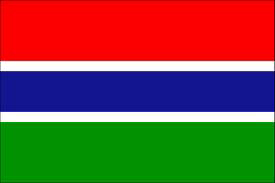Country Profile
ad
 Geographical Location
Geographical Location
The Gambia (officially the Republic of The Gambia) is located in Western Africa and occupies an area of 11,365 sq km. A small sub-tropical country In West Africa, between latitudes 13º28W and 16º36W, it is bordered to the north, south and east by Senegal and has an 80km coast on the Atlantic Ocean to the west. The country’s borders roughly correspond with the path of the River Gambia. The capital city is Banjul and is on Greenwich Mean Time (GMT)
Climate
The Gambia has a sub-tropical climate with two variations of distinct dry and rainy seasons. The dry season commonly known as ‘Harmattan’ usually starts mid-October and ends around mid-June every year with an average temperature of 32°C / 89.6°F. The rainy season usually starts around the mid- June and ends around the mid-October with August being the wettest month of the year, temperatures can reach up to 41°C/105.8°C.
Land
The republic of the Gambia has a total area: 11,365 km2 (4388 sq. miles) and out of this approximately 1,300 km2 is of water bodies with a 80 km coastline with an exclusive fishing zone of 200 nautical miles with continental shelf. The agricultural land is 6,550 km2 and the arable land is 588,000 hectares of which 334,000 hectares are under cultivation and a forest area of 4750 km2 i.e. 47.5% of land area.
The People
The official language of the country is English and the different local languages are Mandinka, Wollof, Fula, Jola, Sarahule, Serere, Manjago and Creole (krio). The Republic of the Gambia’s constitution guarantees freedom of religion. Christianity, Islam and Traditional Religion are the major faiths practiced in the country with the following representation: Christianity (8%), Islam (90%) and traditional religion (2%). The total population of the Gambia according to the 2013 Nation Census was estimated at 1,882,450 inhabitants with average annual growth rate of 3.3%. The population distributions by administrative regions by numbers and percentages are as follows:
The Population
*LGA: Local Government Area
|
LGA* |
Population |
Percentage share of Total Population |
|||
| 2003 | 2013 | 2003 | 2013 | ||
| Banjul | 35,061 | 31,301 | 2.6 | 1.7 | |
| Kanifing | 322,735 | 382,096 | 23.7 | 20.3 | |
| Brikama | 389,594 | 699,704 | 28.6 | 37.2 | |
| Mansakonko | 72,167 | 82,361 | 5.3 | 4.4 | |
| Kerewan | 172,835 | 221,054 | 12.7 | 11.7 | |
| Kuntaur | 78,491 | 99,108 | 5.8 | 5.3 | |
| Janjangbureh | 107,212 | 126,910 | 7.9 | 6.7 | |
| Basse | 182,586 | 239,916 | 13.4 | 12.7 | |
| Total | 1,360,681 | 1,882,450 | 100.0 | 100.0 | |
Population as at 2016 (UN estimates) 2.1million
Administrative Regions
- Central River Region
- Lower River Region
- North Bank Region
- Upper River Region
- West Coast Region
Historical Background
The first written accounts of the region come from Arab traders in the 9th and 10th century. Arab traders established the trans-Saharan trade routes. The Portuguese took control of The Gambia and benefited greatly from the maritime routes. The Gambia was briefly under Polish-Lithuanian rule from 1651 until the River Gambia was ceded to Great Britain under the 1783 Treaty of Versailles.
The Gambia was under British colonial rule from 1816 and served as a strategic enclave against French influence in the sub-Saharan region.
The Gambia achieved independence on February 18, 1965 from the United Kingdom. In 1970, The Gambia became a republic within the Commonwealth, following a second referendum, with Prime Minister Sir Dawda Kairaba Jawara, as Head of State. The Gambia was led by President Jawara, who was re-elected five times.
In July 1994, Yahya A.J.J. Jammeh came into power following a peaceful military coup d'état. Elections were held in 1996 declaring retired colonel Yahya A.J.J. Jammeh as the civilian President of the Second Republic and then sworn into office November 6th, 1996. President Alhagie Yahya A.J.J. Jammeh has remained in office after winning three consecutive elections in 2001, 2006 and 2011 respectively.
In December 2016, elections were held declaring Adama Barrow as the civilian President of the Third Republic and then sworn into office January 19th, 2017. Today, The Gambia remains stable, peaceful and democratic, the economy is picking up slightly and all the sectors within the economy are thriving.
Exchange Rate: US$1=GMD49.50 (Febuary 2019). Visit the Central Bank for the latest exchange rates.
